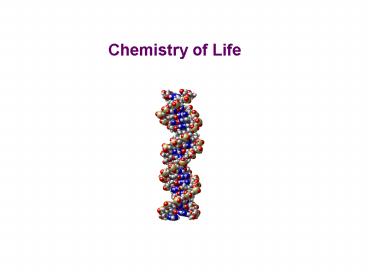Chemistry of Life - PowerPoint PPT Presentation
1 / 24
Title:
Chemistry of Life
Description:
All atoms of an element have same chemical properties. all behave the same ... Elements in the same column have the same valence & similar chemical properties ... – PowerPoint PPT presentation
Number of Views:32
Avg rating:3.0/5.0
Title: Chemistry of Life
1
Chemistry of Life
2
Why are we studying chemistry?
- Biology has chemistry at its foundation
3
The Basics
- Everything is made of matter
- Matter is made of atoms
- Atoms are made of
- protons mass of 1 nucleus
- neutrons 0 mass of 1 nucleus
- electrons - mass ltlt1 orbits
- Different kinds of atoms elements
4
The World of Elements
5
Models of atoms
(c)
6
Atomic structure determines behavior
- The number of protons in an atom determines the
element - of protons atomic number
- this also tells you of electrons
- All atoms of an element have same chemical
properties - all behave the same
- properties dont change
7
Life requires 25 chemical elements
- About 25 elements are essential for life
- Four elements make up 96 of living matter
- carbon (C) hydrogen (H)
- oxygen (O) nitrogen (N)
- Four elements make up most of remaining 4
- phosphorus (P) calcium (Ca)
- sulfur (S) potassium (K)
8
(No Transcript)
9
Bonding properties
- Effect of electrons
- chemical behavior of an atom depends on its
electron arrangement - depends on the number of electrons in its
outermost shell, the valence shell
How does this atom behave?
10
Chemical reactivity
- Atoms tend to
- Complete a partially filled outer (valence)
electron shell - or
- Empty a partially filled outer (valence)
electron shell - This tendency drives chemical reactions
11
Bonding properties
- Effect of electrons
- chemical behavior of an atom depends on number of
electrons in its outermost shell
How does this atom behave?
How does this atom behave?
12
Elements their valence shells
- Elements in the same row have the same number of
shells
13
Elements their valence shells
- Elements in the same column have the same valence
similar chemical properties
14
Elements their valence shells
- Moving from left to right, each element has a
sequential addition of electrons (and protons)
15
Ionic bonds
16
Ionic bonds
Lets go to the video tape! (play movie here)
- Transfer of an electron
- Forms - ions
- cation
- anion
- Weak bond
- example
- salt dissolves easily in water
17
Covalent bonds
- Two atoms need an electron
- Share a pair of electrons
- Strong bond
- both atoms holding onto the electrons
- Forms molecules
- example
- water takes energy to separate
18
Double covalent bonds
- Two atoms can share more than one pair of
electrons - double bonds (2 pairs of electrons)
- triple bonds (3 pairs of electrons)
- Very strong bonds
19
Multiple covalent bonds
- 1 atom can form covalent bonds with two or more
other atoms - forms larger molecules
- ex. carbon
20
Polar covalent bonds
- Pair of electrons not shared equally by 2 atoms
- Water O H
- oxygen has stronger attraction for the shared
electrons than hydrogen - oxygen has higher electronegativity
21
Polar covalent bonds
- 2 hydrogens in the water molecule form an angle
- Water molecule is polar
- oxygen end is
- hydrogen end is
- Leads to many interesting properties of water.
Lets go to the video tape! (play movie here)
22
Hydrogen bonds
- Positive H atom in 1 water molecule is attracted
to negative O in another - Can occur wherever an -OH exists in a larger
molecule - Weak bonds
23
Reductionist view of biology
- Matter is made of atoms
- Life requires 25 chemical elements
- Atomic structure determines behavior of an
element - Atoms combine by chemical bonding to form
molecules - Weak chemical bonds play important roles in
chemistry of life - A molecules biological function is related to
its shape - Chemical reactions make break chemical bonds
24
Any Questions??































